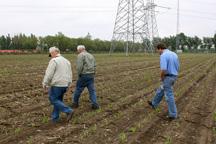 After years as a significant export competitor in Asian markets, China has recently emerged as a net corn importer, and most analysts expect Chinese imports to rise in the near term. The speed and scale of this shift – and the potential of Chinese efforts to ramp up production – are major uncertainties for corn producers and traders around the world.
After years as a significant export competitor in Asian markets, China has recently emerged as a net corn importer, and most analysts expect Chinese imports to rise in the near term. The speed and scale of this shift – and the potential of Chinese efforts to ramp up production – are major uncertainties for corn producers and traders around the world.
These and other questions in the Chinese grain belt were explored last week by a U.S. Grains Council survey team that got a firsthand look at the rapid progress of Chinese agriculture racing to meet surging domestic demand.
U.S. corn growers representing seven states returned Saturday from China, where they surveyed the country’s corn growing conditions and studied Chinese government policies that affect acreage, marketing and demand. Participants of the 2011 U.S. Grains Council Corn Tour met with farmers, traders and provincial officials in the northeastern China provinces of Heilongjiang and Jilin, both major corn producing areas.
“Our goal was to assess last year’s crop availability, this year’s crop potential and try to come up with an idea of what to expect from China in relation to global supply and demand of corn,� said Tom Gillis of the Wisconsin Corn Promotion Board.
Heilongjiang and Jilin provinces each produced 22 million metric tons (866 million bushels) of corn in 2010. Roughly half of the harvest was consumed locally. The remainder was sold and shipped to southern provinces where there is higher population density and feed consumption.
Corn planting acreage for 2011 is expected to generally increase marginally as farmers experienced good prices in 2010 with increased demand. While some increased corn acres have come from wheat and soybean acreage, there is also increased competition for acres from fruits and vegetables, particularly near urban areas. Some land was unplanted and attributed to increased urban encroachment.
“China continues to balance many contending factors such as modern technology, information technology, increasing mechanization and the aging agricultural labor force. There is a vast exodus of young people to the city. We witnessed land loss due to urbanization,� said Floyd Gaibler, USGC director of trade policy, who accompanied the group.
In both Heilongjian and Jilin provinces, emergence is behind normal levels due to rainy weather and low temperatures. The team also observed that germination was spotty in some locations with skipped spaces and an occurrence of hand replanting.
While in China, the seven-member delegation also met with several corn farmers, trade partners and end-users. The group visited grain storage facilities. The delegation also had the opportunity to speak with farmers who run small hog farm operations, using a modern corn-soy ration for feed.
“We had the opportunity to visit some private corn storage facilities, which we felt were well under capacity. Some analysts speculate that government storage of corn is at low levels but there is no effective way to measure it,� said Ken Kindler of Dow AgriSciences LLC. “Farmers sold most of their 2010 production at harvest.�
Other members of the mission included Gary Schmalshof from the Illinois Corn Marketing Board; Dick Gallagher of the Iowa Corn Promotion Board; Dennis Gengenbach from the Nebraska Corn Board; Lori Feltis of the Minnesota Corn Research and Promotion Council; and DeEtta Bohling of the Kansas Corn Commission. The delegation was escorted by USGC staff Dick Kasting, director of strategic relations, and Floyd Gaibler, director of trade policy.
Click here to see more pictures from this mission.


